Page 160 of 560
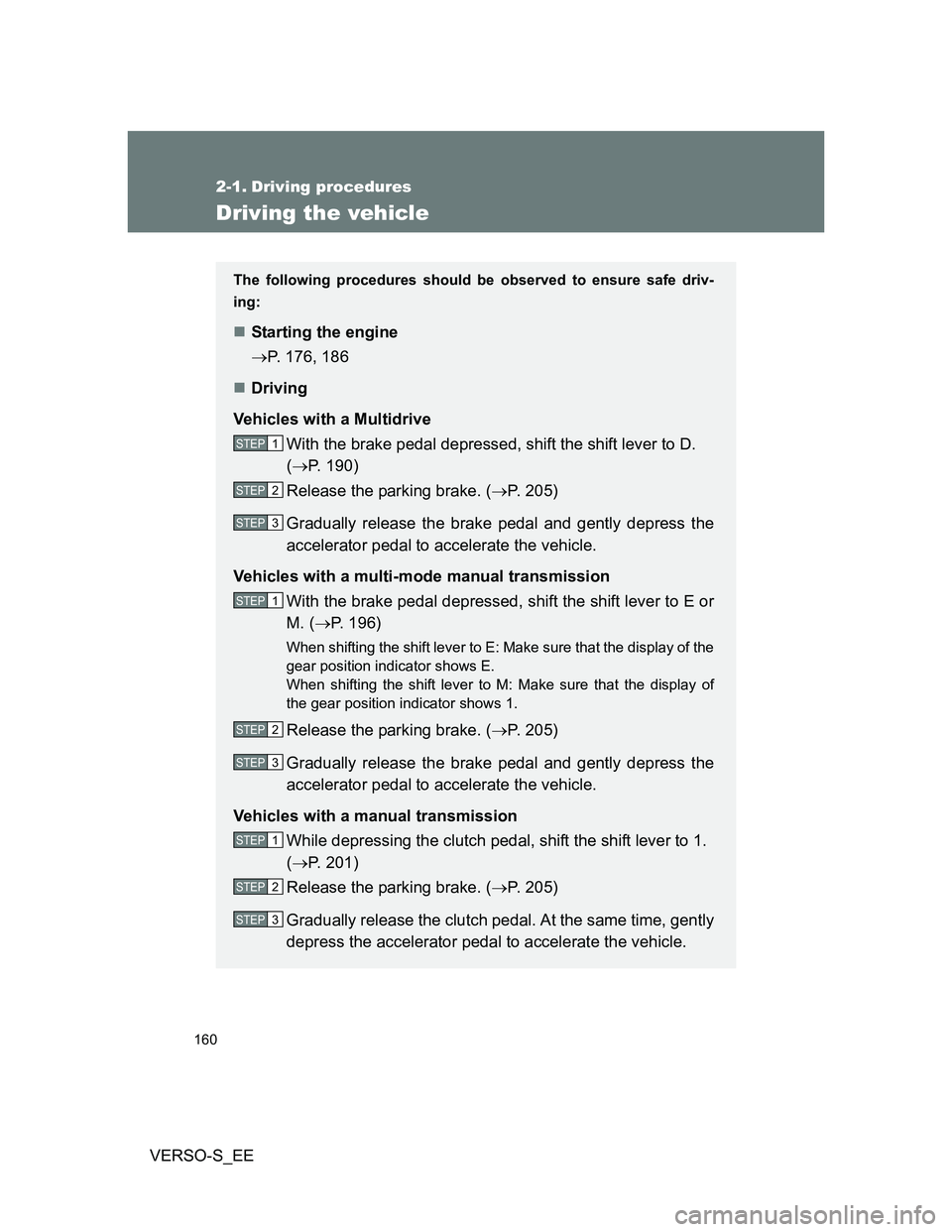
160
VERSO-S_EE
2-1. Driving procedures
Driving the vehicle
The following procedures should be observed to ensure safe driv-
ing:
Starting the engine
P. 176, 186
Driving
Vehicles with a Multidrive
With the brake pedal depressed, shift the shift lever to D.
(P. 190)
Release the parking brake. (P. 205)
Gradually release the brake pedal and gently depress the
accelerator pedal to accelerate the vehicle.
Vehicles with a multi-mode manual transmission
With the brake pedal depressed, shift the shift lever to E or
M. (P. 196)
When shifting the shift lever to E: Make sure that the display of the
gear position indicator shows E.
When shifting the shift lever to M: Make sure that the display of
the gear position indicator shows 1.
Release the parking brake. (P. 205)
Gradually release the brake pedal and gently depress the
accelerator pedal to accelerate the vehicle.
Vehicles with a manual transmission
While depressing the clutch pedal, shift the shift lever to 1.
(P. 201)
Release the parking brake. (P. 205)
Gradually release the clutch pedal. At the same time, gently
depress the accelerator pedal to accelerate the vehicle.
STEP1
STEP2
STEP3
STEP1
STEP2
STEP3
STEP1
STEP2
STEP3
Page 161 of 560
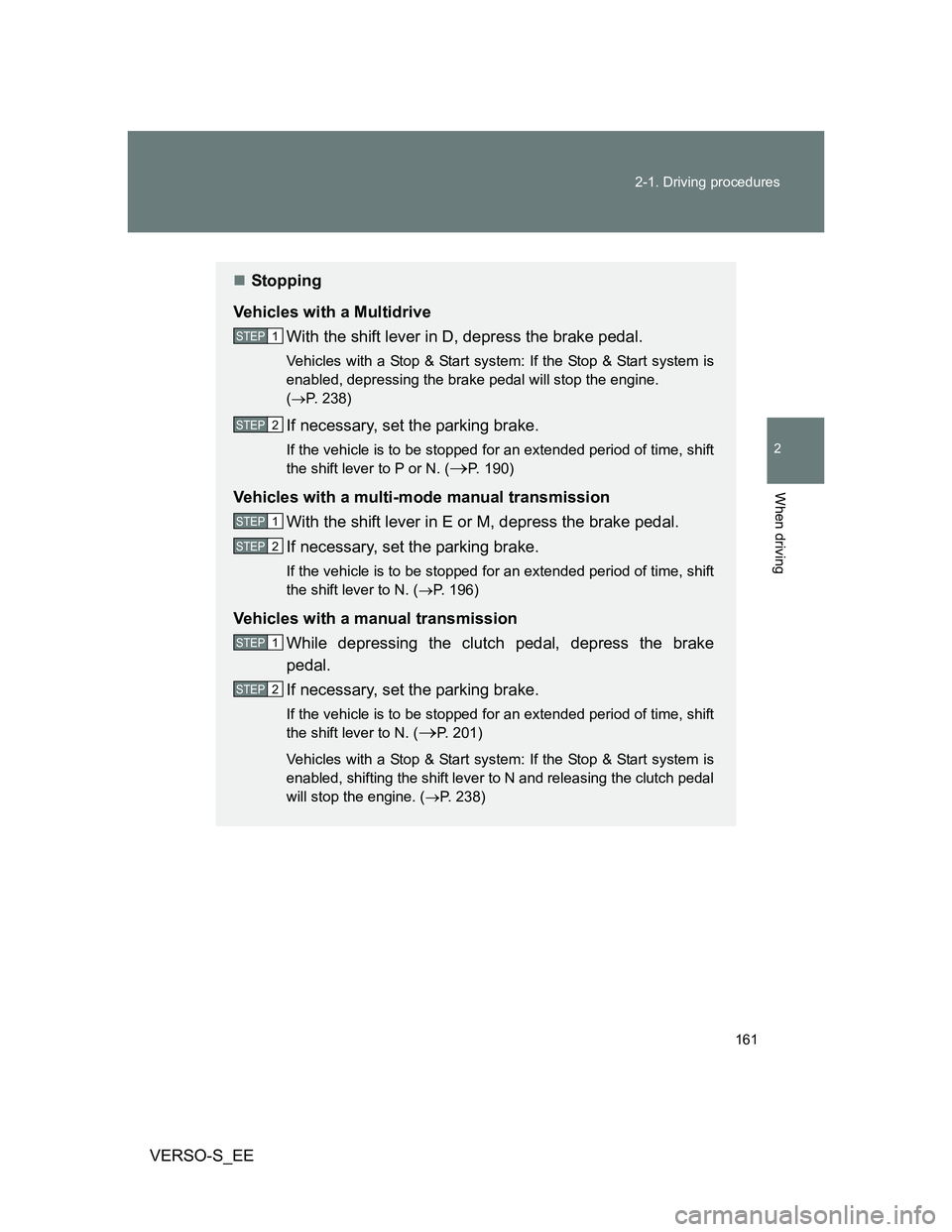
161 2-1. Driving procedures
2
When driving
VERSO-S_EE
Stopping
Vehicles with a Multidrive
With the shift lever in D, depress the brake pedal.
Vehicles with a Stop & Start system: If the Stop & Start system is
enabled, depressing the brake pedal will stop the engine.
(P. 238)
If necessary, set the parking brake.
If the vehicle is to be stopped for an extended period of time, shift
the shift lever to P or N. (
P. 190)
Vehicles with a multi-mode manual transmission
With the shift lever in E or M, depress the brake pedal.
If necessary, set the parking brake.
If the vehicle is to be stopped for an extended period of time, shift
the shift lever to N. (P. 196)
Vehicles with a manual transmission
While depressing the clutch pedal, depress the brake
pedal.
If necessary, set the parking brake.
If the vehicle is to be stopped for an extended period of time, shift
the shift lever to N. (
P. 201)
Vehicles with a Stop & Start system: If the Stop & Start system is
enabled, shifting the shift lever to N and releasing the clutch pedal
will stop the engine. (P. 238)
STEP1
STEP2
STEP1
STEP2
STEP1
STEP2
Page 162 of 560
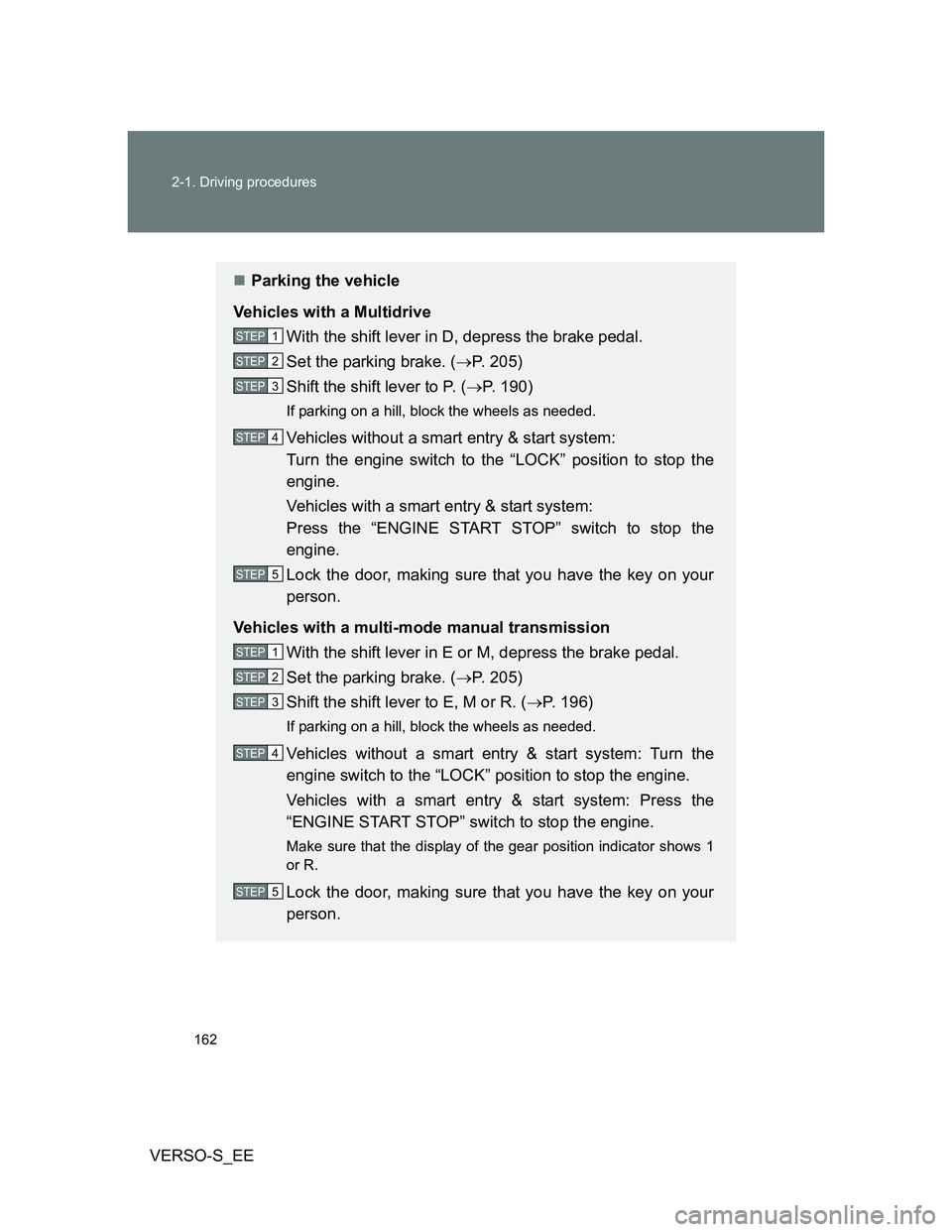
162 2-1. Driving procedures
VERSO-S_EE
Parking the vehicle
Vehicles with a Multidrive
With the shift lever in D, depress the brake pedal.
Set the parking brake. (P. 205)
Shift the shift lever to P. (P. 190)
If parking on a hill, block the wheels as needed.
Vehicles without a smart entry & start system:
Turn the engine switch to the “LOCK” position to stop the
engine.
Vehicles with a smart entry & start system:
Press the “ENGINE START STOP” switch to stop the
engine.
Lock the door, making sure that you have the key on your
person.
Vehicles with a multi-mode manual transmission
With the shift lever in E or M, depress the brake pedal.
Set the parking brake. (P. 205)
Shift the shift lever to E, M or R. (P. 196)
If parking on a hill, block the wheels as needed.
Vehicles without a smart entry & start system: Turn the
engine switch to the “LOCK” position to stop the engine.
Vehicles with a smart entry & start system: Press the
“ENGINE START STOP” switch to stop the engine.
Make sure that the display of the gear position indicator shows 1
or R.
Lock the door, making sure that you have the key on your
person.
STEP1
STEP2
STEP3
STEP4
STEP5
STEP1
STEP2
STEP3
STEP4
STEP5
Page 163 of 560
163 2-1. Driving procedures
2
When driving
VERSO-S_EE
Vehicles with a manual transmission
While depressing the clutch pedal, depress the brake
pedal.
Set the parking brake. (P. 205)
Shift the shift lever to N. (P. 201)
If parking on a hill, shift the shift lever to 1 or R and block the
wheels as needed.
Vehicles without a smart entry & start system: Turn the
engine switch to the “LOCK” position to stop the engine.
Vehicles with a smart entry & start system: Press the
“ENGINE START STOP” switch to stop the engine.
Lock the door, making sure that you have the key on your
person.
STEP1
STEP2
STEP3
STEP4
STEP5
Page 165 of 560
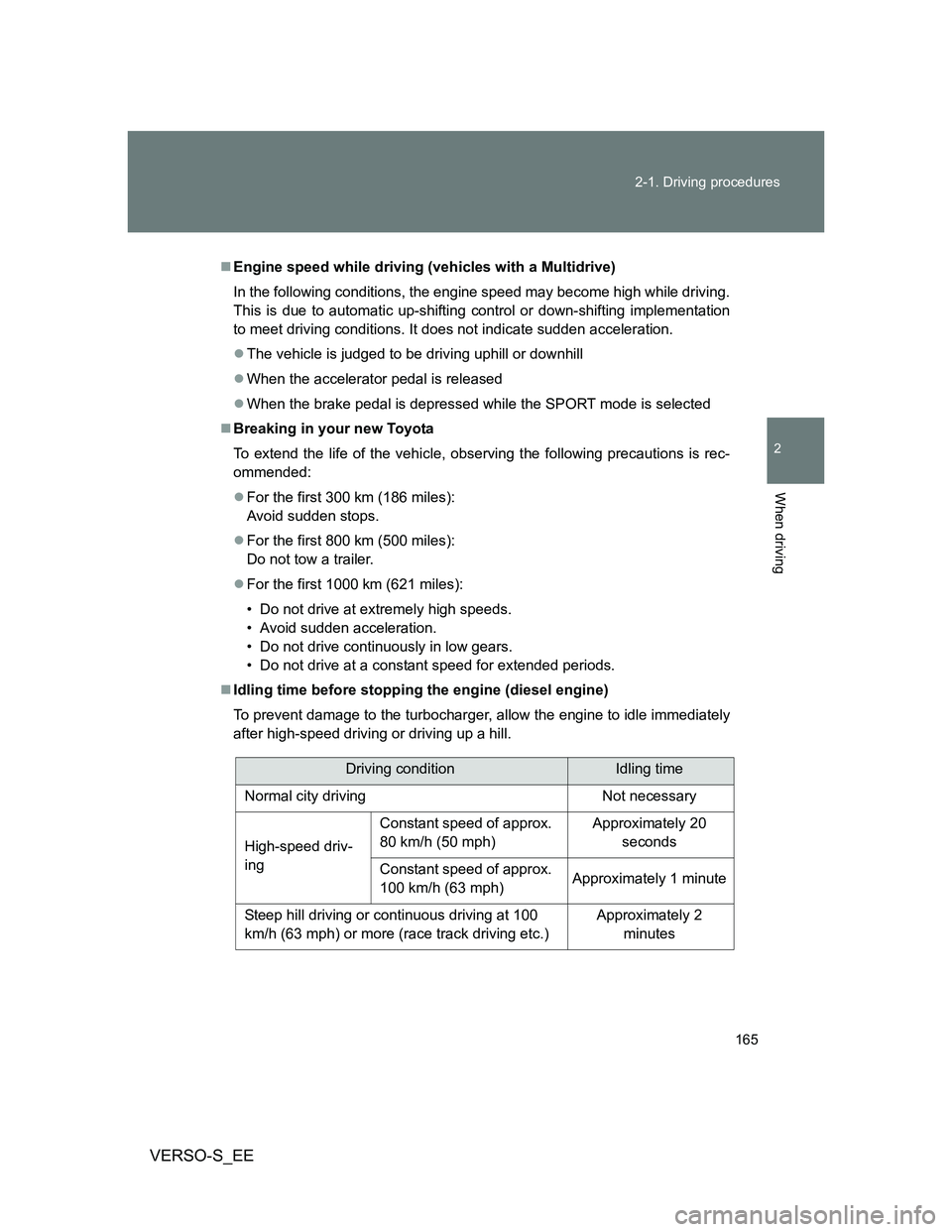
165 2-1. Driving procedures
2
When driving
VERSO-S_EE
Engine speed while driving (vehicles with a Multidrive)
In the following conditions, the engine speed may become high while driving.
This is due to automatic up-shifting control or down-shifting implementation
to meet driving conditions. It does not indicate sudden acceleration.
The vehicle is judged to be driving uphill or downhill
When the accelerator pedal is released
When the brake pedal is depressed while the SPORT mode is selected
Breaking in your new Toyota
To extend the life of the vehicle, observing the following precautions is rec-
ommended:
For the first 300 km (186 miles):
Avoid sudden stops.
For the first 800 km (500 miles):
Do not tow a trailer.
For the first 1000 km (621 miles):
• Do not drive at extremely high speeds.
• Avoid sudden acceleration.
• Do not drive continuously in low gears.
• Do not drive at a constant speed for extended periods.
Idling time before stopping the engine (diesel engine)
To prevent damage to the turbocharger, allow the engine to idle immediately
after high-speed driving or driving up a hill.
Driving conditionIdling time
Normal city driving Not necessary
High-speed driv-
ingConstant speed of approx.
80 km/h (50 mph)Approximately 20
seconds
Constant speed of approx.
100 km/h (63 mph)Approximately 1 minute
Steep hill driving or continuous driving at 100
km/h (63 mph) or more (race track driving etc.)Approximately 2
minutes
Page 166 of 560
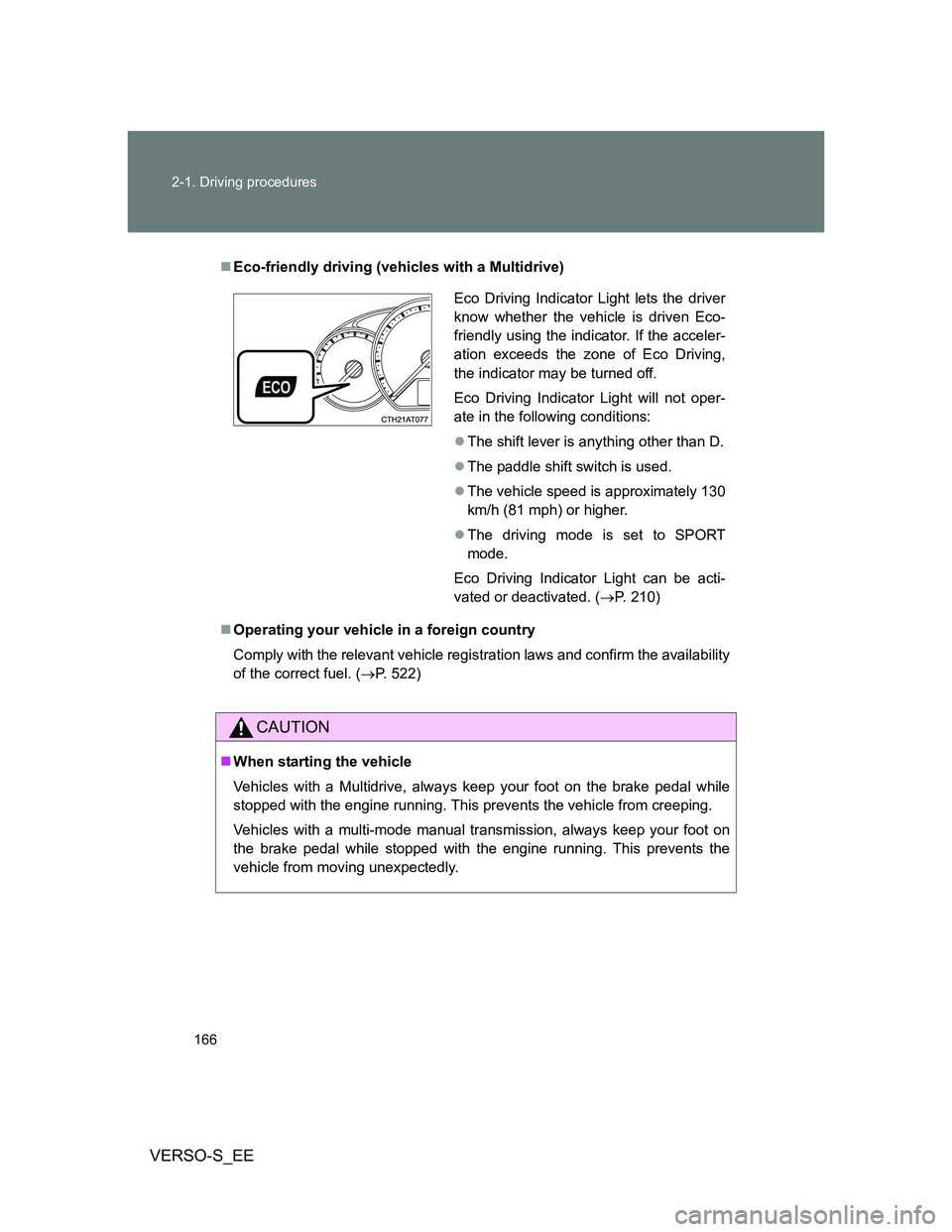
166 2-1. Driving procedures
VERSO-S_EE
Eco-friendly driving (vehicles with a Multidrive)
Operating your vehicle in a foreign country
Comply with the relevant vehicle registration laws and confirm the availability
of the correct fuel. (P. 522)
CAUTION
When starting the vehicle
Vehicles with a Multidrive, always keep your foot on the brake pedal while
stopped with the engine running. This prevents the vehicle from creeping.
Vehicles with a multi-mode manual transmission, always keep your foot on
the brake pedal while stopped with the engine running. This prevents the
vehicle from moving unexpectedly.
Eco Driving Indicator Light lets the driver
know whether the vehicle is driven Eco-
friendly using the indicator. If the acceler-
ation exceeds the zone of Eco Driving,
the indicator may be turned off.
Eco Driving Indicator Light will not oper-
ate in the following conditions:
The shift lever is anything other than D.
The paddle shift switch is used.
The vehicle speed is approximately 130
km/h (81 mph) or higher.
The driving mode is set to SPORT
mode.
Eco Driving Indicator Light can be acti-
vated or deactivated. (P. 210)
Page 167 of 560
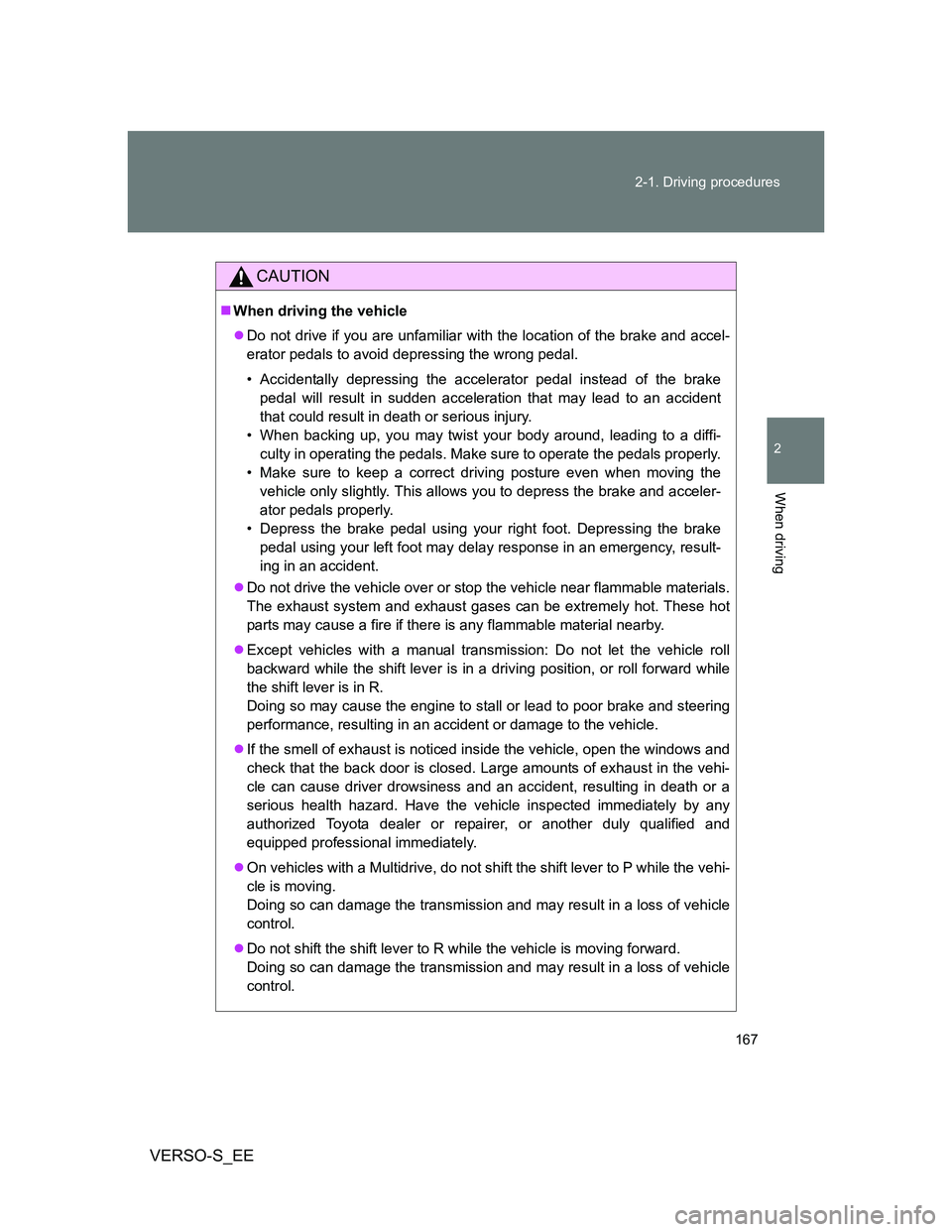
167 2-1. Driving procedures
2
When driving
VERSO-S_EE
CAUTION
When driving the vehicle
Do not drive if you are unfamiliar with the location of the brake and accel-
erator pedals to avoid depressing the wrong pedal.
• Accidentally depressing the accelerator pedal instead of the brake
pedal will result in sudden acceleration that may lead to an accident
that could result in death or serious injury.
• When backing up, you may twist your body around, leading to a diffi-
culty in operating the pedals. Make sure to operate the pedals properly.
• Make sure to keep a correct driving posture even when moving the
vehicle only slightly. This allows you to depress the brake and acceler-
ator pedals properly.
• Depress the brake pedal using your right foot. Depressing the brake
pedal using your left foot may delay response in an emergency, result-
ing in an accident.
Do not drive the vehicle over or stop the vehicle near flammable materials.
The exhaust system and exhaust gases can be extremely hot. These hot
parts may cause a fire if there is any flammable material nearby.
Except vehicles with a manual transmission: Do not let the vehicle roll
backward while the shift lever is in a driving position, or roll forward while
the shift lever is in R.
Doing so may cause the engine to stall or lead to poor brake and steering
performance, resulting in an accident or damage to the vehicle.
If the smell of exhaust is noticed inside the vehicle, open the windows and
check that the back door is closed. Large amounts of exhaust in the vehi-
cle can cause driver drowsiness and an accident, resulting in death or a
serious health hazard. Have the vehicle inspected immediately by any
authorized Toyota dealer or repairer, or another duly qualified and
equipped professional immediately.
On vehicles with a Multidrive, do not shift the shift lever to P while the vehi-
cle is moving.
Doing so can damage the transmission and may result in a loss of vehicle
control.
Do not shift the shift lever to R while the vehicle is moving forward.
Doing so can damage the transmission and may result in a loss of vehicle
control.
Page 168 of 560
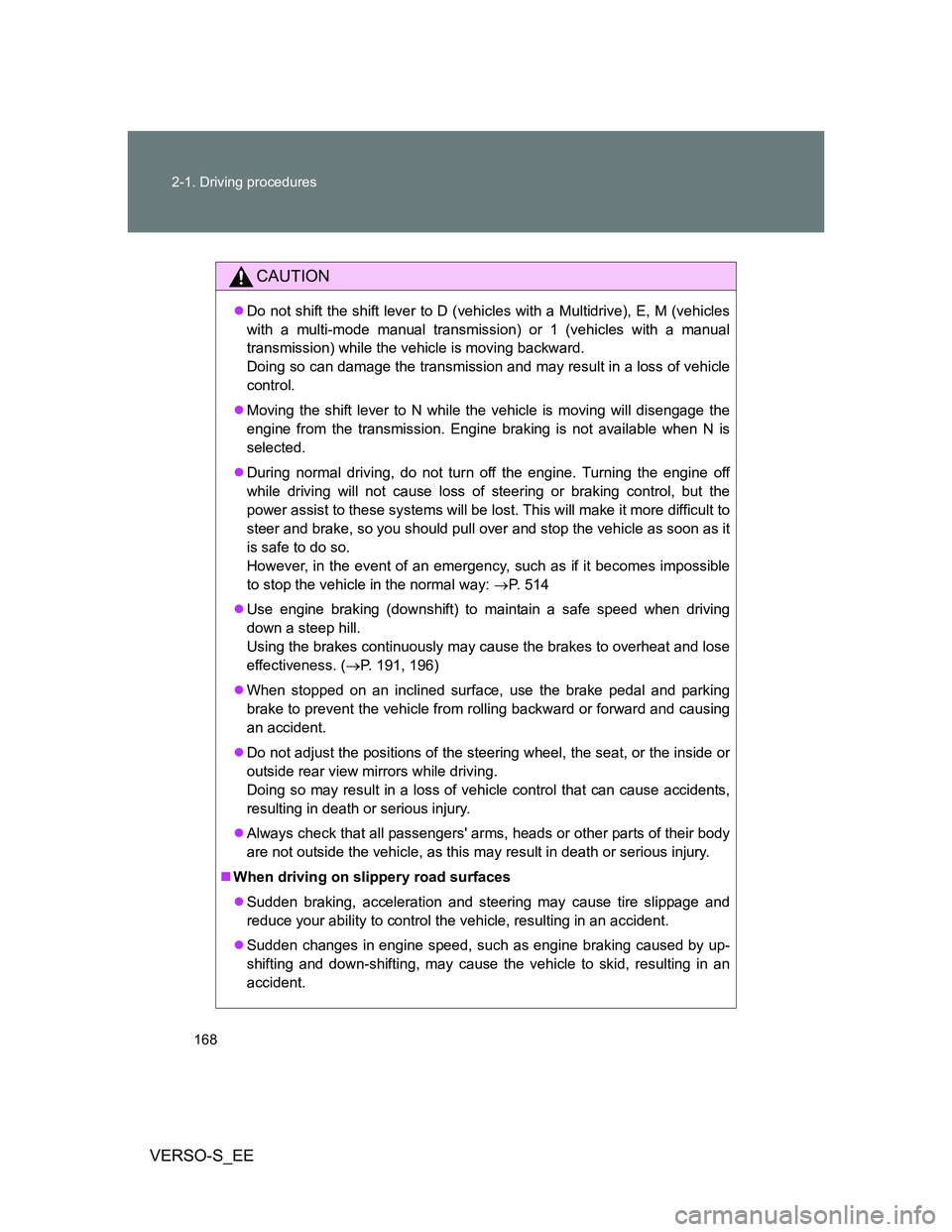
168 2-1. Driving procedures
VERSO-S_EE
CAUTION
Do not shift the shift lever to D (vehicles with a Multidrive), E, M (vehicles
with a multi-mode manual transmission) or 1 (vehicles with a manual
transmission) while the vehicle is moving backward.
Doing so can damage the transmission and may result in a loss of vehicle
control.
Moving the shift lever to N while the vehicle is moving will disengage the
engine from the transmission. Engine braking is not available when N is
selected.
During normal driving, do not turn off the engine. Turning the engine off
while driving will not cause loss of steering or braking control, but the
power assist to these systems will be lost. This will make it more difficult to
steer and brake, so you should pull over and stop the vehicle as soon as it
is safe to do so.
However, in the event of an emergency, such as if it becomes impossible
to stop the vehicle in the normal way: P. 514
Use engine braking (downshift) to maintain a safe speed when driving
down a steep hill.
Using the brakes continuously may cause the brakes to overheat and lose
effectiveness. (P. 191, 196)
When stopped on an inclined surface, use the brake pedal and parking
brake to prevent the vehicle from rolling backward or forward and causing
an accident.
Do not adjust the positions of the steering wheel, the seat, or the inside or
outside rear view mirrors while driving.
Doing so may result in a loss of vehicle control that can cause accidents,
resulting in death or serious injury.
Always check that all passengers' arms, heads or other parts of their body
are not outside the vehicle, as this may result in death or serious injury.
When driving on slippery road surfaces
Sudden braking, acceleration and steering may cause tire slippage and
reduce your ability to control the vehicle, resulting in an accident.
Sudden changes in engine speed, such as engine braking caused by up-
shifting and down-shifting, may cause the vehicle to skid, resulting in an
accident.